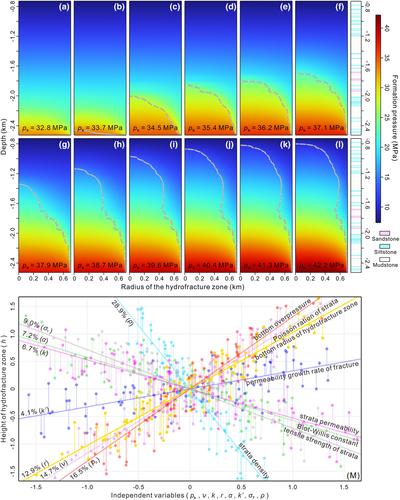当前位置:
X-MOL 学术
›
Basin Res.
›
论文详情
Our official English website, www.x-mol.net, welcomes your
feedback! (Note: you will need to create a separate account there.)
Overpressure‐driven hydrofracture growth in the northern South China Sea
Basin Research ( IF 2.8 ) Pub Date : 2024-08-13 , DOI: 10.1111/bre.12894 Qing Wang 1 , Qiliang Sun 1, 2 , Kehua You 3 , Martino Foschi 4, 5
Basin Research ( IF 2.8 ) Pub Date : 2024-08-13 , DOI: 10.1111/bre.12894 Qing Wang 1 , Qiliang Sun 1, 2 , Kehua You 3 , Martino Foschi 4, 5
Affiliation

|
Overpressure‐driven hydrofracturing pervasively occurs in sedimentary basins worldwide. Hydrofracture zones can vertically penetrate several kilometres of rocks and are dominant pathways for basin‐scale fluid migration and energy circulations. Although hydrofracture zones have been extensively described and analysed in the literature, the mechanisms on how hydrofracture zones form and evolve are still poorly understood. In this study, we explore the formation and evolution of a hydrofracture zone in the northern South China Sea, using numerical models constrained by borehole and seismic data. We show that the radius of hydrofracture zone decreases with the strata permeability. The growth of hydrofracture zone is mainly controlled by rock density (), pressure at the origin of hydrofracture zone (p b ), Poisson's ratio (v ), and the radius of the hydrofracture zone at its origin (r ). Moreover, as the hydrofracture zone grows, a transition layer forms between the overpressured hydrofracture zone and the overlying hydrostatic pressure zone. The thickness of this transition layer is controlled by strata permeability, strata thickness, overpressure, and pressure gradient within the hydrofracture zone. This study quantitatively explores the development and evolution of overpressure‐driven hydrofractures for the first time, and has wide applications in geohazard assessment, hydrocarbon exploration, carbon circulation, and climatic change.
中文翻译:

南海北部超压驱动的水力压裂增长
超压驱动的水力压裂普遍发生在全世界的沉积盆地中。水力压裂带可以垂直穿透数公里的岩石,是盆地规模流体运移和能量循环的主要通道。尽管水力压裂带在文献中得到了广泛的描述和分析,但人们对水力压裂带如何形成和演化的机制仍然知之甚少。在这项研究中,我们利用受钻孔和地震数据约束的数值模型,探索南海北部水力压裂带的形成和演化。我们发现水力压裂区的半径随着地层渗透率的增加而减小。水力裂缝带的扩展主要受岩石密度()、水力裂缝带起始处压力( p乙), 泊松比 ( v ),以及水力压裂带原点的半径( r )。此外,随着水力压裂区的生长,在超压水力压裂区和上覆的静水压力区之间形成过渡层。该过渡层的厚度由地层渗透率、地层厚度、超压和水力压裂区内的压力梯度控制。该研究首次定量探讨了超压驱动的水力压裂的发育和演化,在地质灾害评估、油气勘探、碳循环和气候变化等方面具有广泛的应用。
更新日期:2024-08-13
中文翻译:

南海北部超压驱动的水力压裂增长
超压驱动的水力压裂普遍发生在全世界的沉积盆地中。水力压裂带可以垂直穿透数公里的岩石,是盆地规模流体运移和能量循环的主要通道。尽管水力压裂带在文献中得到了广泛的描述和分析,但人们对水力压裂带如何形成和演化的机制仍然知之甚少。在这项研究中,我们利用受钻孔和地震数据约束的数值模型,探索南海北部水力压裂带的形成和演化。我们发现水力压裂区的半径随着地层渗透率的增加而减小。水力裂缝带的扩展主要受岩石密度()、水力裂缝带起始处压力( p乙), 泊松比 ( v ),以及水力压裂带原点的半径( r )。此外,随着水力压裂区的生长,在超压水力压裂区和上覆的静水压力区之间形成过渡层。该过渡层的厚度由地层渗透率、地层厚度、超压和水力压裂区内的压力梯度控制。该研究首次定量探讨了超压驱动的水力压裂的发育和演化,在地质灾害评估、油气勘探、碳循环和气候变化等方面具有广泛的应用。

































 京公网安备 11010802027423号
京公网安备 11010802027423号